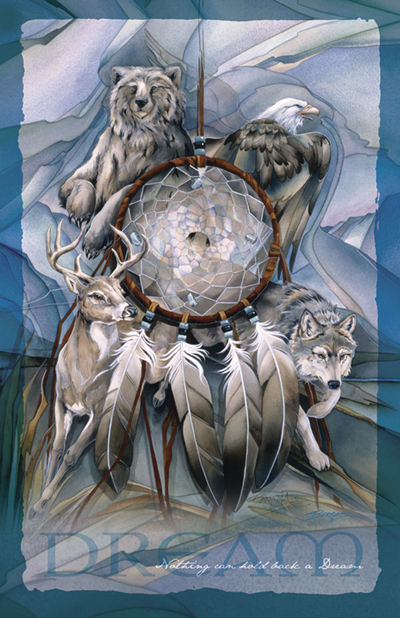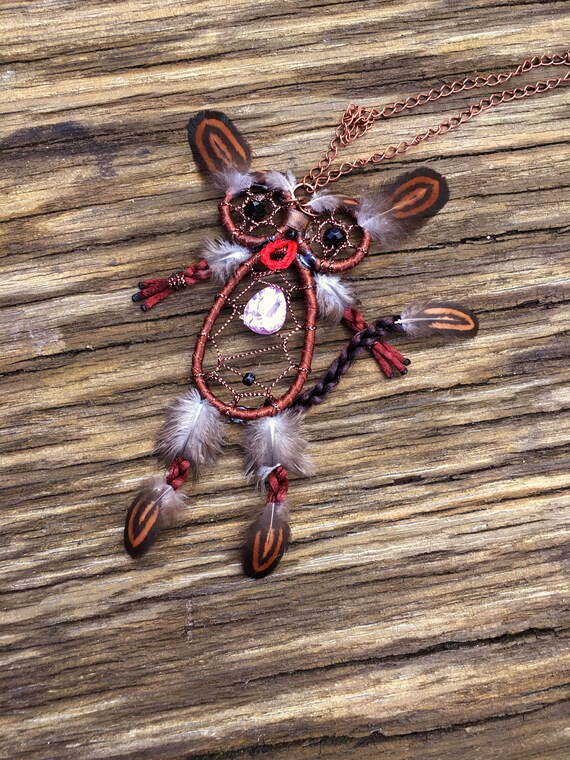Animal Dream Catchers
In some Native American and First Nations cultures, a dreamcatcher or dream catcher (Ojibwe: asabikeshiinh, the inanimate form of the word for 'spider')[1] is a handmade willow hoop, on which is woven a net or web. The dreamcatcher may also include sacred items such as certain feathers or beads. Traditionally they are often hung over a cradle as protection.[2] It originates in Anishinaabe culture as the 'spider web charm' (Anishinaabe: asubakacin 'net-like', White Earth Band; bwaajige ngwaagan 'dream snare', Curve Lake Band[3]), a hoop with woven string or sinew meant to replicate a spider's web, used as a protective charm for infants.[2]
All of the elements of the dream catcher together represent the earth, fire and water. Things we need to live. So when I make a Dream catcher the feathers are of the Eagle one of our most Sacred Animal Spirit. Before being a fashion object, the dreamcatcher was a mystic object used to take away the bad dreams and the bad thoughts before sleeping. Beautiful Dreamcatcher to print Dreamcatcher to print and color: keys Coloring page of a magnificent dreamcatcher.

- Real animal dream catcher feather deer antler drift wood base buffalo tooth rabbit fur glass bead Native American Indian style. From shop amysoddstuff. 5 out of 5 stars. (76) 76 reviews. Only 1 available and it's in 1 person's cart.
- Jun 22, 2016 - Various dreamcatchers I've made with animals figures. See more ideas about dream catcher diy, animal figures, dream catcher.
Dreamcatchers were adopted in the Pan-Indian Movement of the 1960s and 1970s and gained popularity as a widely marketed 'Native crafts items' in the 1980s. [4]
Ojibwe origin[edit]
Mar 27, 2017 - Explore Beth Loveless's board 'Animal Art/Dream Catchers', followed by 199 people on Pinterest. See more ideas about animal art, art, animals.
Ethnographer Frances Densmore in 1929 recorded an Ojibwe legend according to which the 'spiderwebs' protective charms originate with Spider Woman, known as Asibikaashi; who takes care of the children and the people on the land. As the Ojibwe Nation spread to the corners of North America it became difficult for Asibikaashi to reach all the children.[2] So the mothers and grandmothers weave webs for the children, using willow hoops and sinew, or cordage made from plants. The purpose of these charms is apotropaic and not explicitly connected with dreams:
Even infants were provided with protective charms. Examples of these are the 'spiderwebs' hung on the hoop of a cradle board. In old times this netting was made of nettle fiber. Two spider webs were usually hung on the hoop, and it was said that they 'caught any harm that might be in the air as a spider's web catches and holds whatever comes in contact with it.'[2]
Basil Johnston, an elder from Neyaashiinigmiing, in his Ojibway Heritage (1976) gives the story of Spider (Ojibwe: asabikeshiinh, 'little net maker') as a trickster figure catching Snake in his web.[5][clarification needed]
Modern uses[edit]
While Dreamcatchers continue to be used in a traditional manner in their communities and cultures of origin, a derivative form of 'dreamcatchers' were also adopted into the Pan-Indian Movement of the 1960s and 1970s as a symbol of unity among the various Native American cultures, or a general symbol of identification with Native American or First Nations cultures.[4]
The name 'dream catcher' was published in mainstream, non-Native media in the 1970s[6] and became widely known as a 'Native crafts item' by the 1980s,[7]by the early 1990s 'one of the most popular and marketable' ones.[8]
In the course of becoming popular outside the Ojibwe Nation during the Pan-Native movement in the '60s, various types of 'dreamcatchers', many of which bear little resemblance to traditional styles, and that incorporate materials that would not be traditionally used, are now made, exhibited, and sold by New age groups and individuals. Some Native Americans have come to see these 'dreamcatchers' as over-commercialized, like 'sort of the Indian equivalent of a tacky plastic Jesus hanging in your truck,' while others find it a loving tradition or symbol of native unity. [4]


A mounted and framed dreamcatcher is being used as a shared symbol of hope and healing by the Little Thunderbirds Drum and Dance Troupe from the Red Lake Indian Reservation in Minnesota. In recognition of the shared trauma and loss experienced, both at their school during the Red Lake shootings, and by other students who have survived similar school shootings, they have traveled to other schools to meet with students, share songs and stories, and gift them with the dreamcatcher. The dreamcatcher has now been passed from Red Lake to students at Columbine CO, to Sandy Hook CT, to Marysville WA, to Townville SC, to Parkland FL.[9][10][11]
See also[edit]
References[edit]
- ^'Free English-Ojibwe dictionary and translator - FREELANG'. www.freelang.net.
- ^ abcdDensmore, Frances (1929, 1979) Chippewa Customs. Minn. Hist. Soc. Press; pg. 113.
- ^Jim Great Elk Waters, View from the Medicine Lodge (2002), p. 111.
- ^ abc'During the pan-Indian movement in the 60's and 70's, Ojibway dreamcatchers started to get popular in other Native American tribes, even those in disparate places like the Cherokee, Lakota, and Navajo.' 'Native American Dream catchers', Native-Languages
- ^John Borrows, 'Foreword' to Françoise Dussart, Sylvie Poirier, Entangled Territorialities: Negotiating Indigenous Lands in australia and Canada, University of Toronto Press, 2017.
- ^'a hoop laced to resemble a cobweb is one of Andrea Petersen's prize possessions. It is a 'dream catcher'—hung over a Chippewa Indian infant's cradle to keep bad dreams from passing through. 'I hope I can help my students become dream catchers,' she says of the 16 children in her class. In a two-room log cabin elementary school on a Chippewa reservation in Grand Portage' The Ladies' Home Journal 94 (1977), p. 14.
- ^'Audrey Speich will be showing Indian Beading, Birch Bark Work, and Quill Work. She will also demonstrate the making of Dream Catchers and Medicine Bags.' The Society Newsletter (1985), p. 31.
- ^Terry Lusty (2001). 'Where did the Ojibwe dream catcher come from? Windspeaker - AMMSA'. www.ammsa.com. Sweetgrass; volume 8, issue 4: The Aboriginal Multi-Media Society. p. 19.CS1 maint: location (link)
- ^Marysville School District receives dreamcatcher given to Columbine survivors By Brandi N. Montreuil, Tulalip News. Posted on November 7, 2014
- ^'Showing Newtown they're not alone - CNN Video' – via edition.cnn.com.
- ^Dreamcatcher for school shooting survivors (paywall)
Native American Wolf Dream Catchers
External links[edit]
| Wikimedia Commons has media related to Dreamcatcher. |
Animal Dream Catchers Owl
Answer: Dream catchers have long been a part of Native American religion, lore, and art, originating with the Ojibwe, or Chippewa, and the Lakota, a confederation of seven Sioux tribes. Dream catchers are webbed and beaded circles hung with feathers from the base of the circle. As one might suspect, the purpose of a dream catcher is to catch dreams—that is, to trap bad or evil dreams and channel good dreams to the sleeper. Dream catchers are usually placed in a window or above the bed, allowing the good dreams to drip down the feathers onto the sleeper below.
Essentially, a dream catcher is intended to manipulate the spirit world. Some people believe in the efficacy of dream catchers. Others are unsure but are superstitious enough to keep one in the bedroom. Still others see dream catchers as part of a cultural history or a piece of art that looks good dangling from a rear-view mirror.
Animal Dream Catchers Bear
 Knowing the background of dream catchers and their talisman-like use, many Christians want nothing to do with them. Is such concern warranted? A passage in 1 Corinthians 8 may be helpful. Paul is speaking to Christians living in an extremely pagan culture ruled by superstition, magic, and sacrifices, all done in the name of various idols. The sacrifices were a particular concern, for the meat sacrificed was then sold at market. Some Christians felt eating sacrificed meat was endorsing the sacrifice and therefore inappropriate for a Christian; others believed that, since they were not worshiping the idol themselves, it was not wrong.
Knowing the background of dream catchers and their talisman-like use, many Christians want nothing to do with them. Is such concern warranted? A passage in 1 Corinthians 8 may be helpful. Paul is speaking to Christians living in an extremely pagan culture ruled by superstition, magic, and sacrifices, all done in the name of various idols. The sacrifices were a particular concern, for the meat sacrificed was then sold at market. Some Christians felt eating sacrificed meat was endorsing the sacrifice and therefore inappropriate for a Christian; others believed that, since they were not worshiping the idol themselves, it was not wrong.Paul’s guidance was this: “There may be so-called gods in heaven or on earth—as indeed there are many “gods” and many “lords”—yet for us there is one God. . . . However, not all possess this knowledge. But some, through former association with idols, eat food as really offered to an idol, and their conscience, being weak, is defiled” (1 Corinthians 8:5–7). Ultimately, “food will not commend us to God. We are no worse off if we do not eat, and no better off if we do,” yet we must be careful “that this right of yours does not somehow become a stumbling block to the weak” (1 Corinthians 8:8, 9). Just as it was with meat associated with idolatry in the 1st century, so it is with superstitious objects in the 21st.
The Christian understands that false gods are nothing and that a dream catcher has no power in itself. The believer in Christ could easily see a dream catcher as nothing more than a craft or a cultural expression. However, before he buys a dream catcher and hangs it in the window, he should consider other people’s reactions to it. Will others see it as a charm to manipulate the spirit world? Will someone assume the one in possession of a dream catcher approves of Indian religions? Keeping a dream catcher is a matter of conscience; as long as it is not used as a good luck charm, it is innocent enough. But consideration must be given to those we seek to minister to.